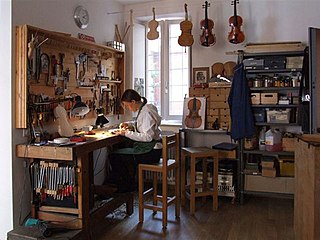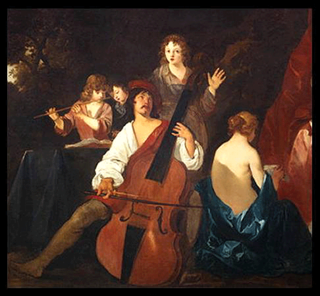The viola is a stringed musical instrument related to the violin. Viola also may refer to:
The viola is a stringed musical instrument related to the violin. Viola also may refer to:
Viola is a term for several Portuguese and Brazilian regional folk guitars, frequently called simply "viola" in their respective regions:

The violoncello ( VY-ə-lən-CHEL-oh, Italian pronunciation:[vjolonˈtʃɛllo]), often simply abbreviated as cello ( CHEL-oh), is a bowed (sometimes plucked and occasionally hit) string instrument of the violin family. Its four strings are usually tuned in perfect fifths: from low to high, C2, G2, D3 and A3. The viola's four strings are each an octave higher. Music for the cello is generally written in the bass clef, with tenor clef, and treble clef used for higher-range passages.

The viol, viola da gamba, or informally gamba, is any one of a family of bowed, fretted, and stringed instruments with hollow wooden bodies and pegboxes where the tension on the strings can be increased or decreased to adjust the pitch of each of the strings. Frets on the viol are usually made of gut, tied on the fingerboard around the instrument's neck, to enable the performer to stop the strings more cleanly. Frets improve consistency of intonation and lend the stopped notes a tone that better matches the open strings. Viols first appeared in Spain and Italy in the mid-to-late 15th century, and were most popular in the Renaissance and Baroque (1600–1750) periods. Early ancestors include the Arabic rebab and the medieval European vielle, but later, more direct possible ancestors include the Venetian viole and the 15th- and 16th-century Spanish vihuela, a six-course plucked instrument tuned like a lute that looked like but was quite distinct from the four-course guitar.

The viola d'amore is a 7- or 6-stringed musical instrument with sympathetic strings used chiefly in the baroque period. It is played under the chin in the same manner as the violin.

The vihuela is a 15th-century fretted plucked Spanish string instrument, shaped like a guitar but tuned like a lute. It was used in 15th- and 16th-century Spain as the equivalent of the lute in Italy and has a large resultant repertory. There were usually five or six doubled strings.

The berimbau is a traditional Angolan musical bow that is commonly used in Brazil. It is also known as Sekitulege among the Baganda and Busoga.

A luthier is a craftsperson who builds or repairs string instruments that have a neck and a sound box.

The viola caipira, often simply viola or brazilian viola, is a Brazilian ten-string guitar with five courses of strings arranged in pairs. It was introduced in the state of São Paulo, where it is widely played as the basis for the música caipira, a type of folk-country music originating in the Caipira country of south-central Brazil.
Bowed string instruments are a subcategory of string instruments that are played by a bow rubbing the strings. The bow rubbing the string causes vibration which the instrument emits as sound.

The term violone can refer to several distinct large, bowed musical instruments which belong to either the viol or violin family. The violone is sometimes a fretted instrument, and may have six, five, four, or even only three strings. The violone is also not always a contrabass instrument. In modern parlance, one usually tries to clarify the 'type' of violone by adding a qualifier based on the tuning or on geography, or by using other terms that have a more precise connotation. The term violone may be used correctly to describe many different instruments, yet distinguishing among these types can be difficult, especially for those not familiar with the historical instruments of the viol and violin families and their respective variations in tuning.
Hille Perl is a German virtuoso performer of the viola da gamba and lirone.

The violin family of musical instruments was developed in Italy in the 16th century. At the time the name of this family of instruments was viole da braccio which was used to distinguish them from the viol family. The standard modern violin family consists of the violin, viola, cello, and (possibly) double bass.

The violin, viola and cello were first built in the early 16th century, in Italy. The earliest evidence for their existence is in paintings by Gaudenzio Ferrari from the 1530s, though Ferrari's instruments had only three strings. The Académie musicale, a treatise written in 1556 by Philibert Jambe de Fer, gives a clear description of the violin family much as we know it today.
In music, standard tuning refers to the typical tuning of a string instrument. This notion is contrary to that of scordatura, i.e. an alternate tuning designated to modify either the timbre or technical capabilities of the desired instrument.

In music, a trio is any of the following:
Giannini is a Brazilian musical instruments manufacturing company, based in Salto, São Paulo.

Bass violin is the modern term for various 16th- and 17th-century bass instruments of the violin family. They were the direct ancestor of the modern cello. Bass violins were usually somewhat larger than the modern cello, but tuned to the same nominal pitches or sometimes one step lower. Contemporaneous names for these instruments include "basso de viola da braccio," "basso da braccio," or the generic term "violone," which simply meant "large fiddle." The instrument differed from the violone of the viol, or "viola da gamba" family in that like the other violins it had at first three, and later usually four strings, as opposed to five, six, or seven strings, it was tuned in fifths, and it had no frets. With its F-holes and stylized C-bouts it also more closely resembled the viola da braccio.

Guido Antonio Santórsola di Bari Bruno was a Brazilian-Uruguayan composer, violinist, violist, viola d'amore player, and conductor of Italian birth.

Viola da braccio is a term variously applied during the baroque period to instruments of the violin family, in distinction to the viola da gamba and the viol family to which the latter belongs. At first "da braccio" seems to encompass the entire violin family. Monteverdi's Orfeo designates an entire six-part string section "viole da brazzo", apparently including bass instruments held between the knees like the cello and bass violin. His Selva morale (1641) contains a piece calling for "due violini & 3 viole da brazzo ouero 3 Tronboni", reflecting a general shift in meaning towards the lower instruments. Eventually it came to be reserved for the alto member, the viola. A famous example is Bach's Sixth Brandenburg Concerto (1721), combining two viole da braccio with two viole da gamba. The German word for viola, Bratsche, is a relic of this last use.